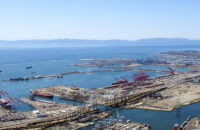The U.S. Dept. of Transportation continues its rollout of funding from the Infrastructure Investment and Jobs Act, seeking applications for a new airport terminal grant program and for an expanded maritime port grant program.
DOT’s Federal Aviation Administration on Feb. 22 issued a “notice of funding opportunity" for $1 billion in Airport Terminal Program grants. The amount represents the fiscal year 2022 portion of a five-year, $5-billion allocation for the program which was created under the Infrastructure Investment and Jobs Act.
Types of projects eligible for the grants include replacements for aging terminals, capacity expansions, facility relocations to improve safety, plus measures to increase energy efficiency, improve access for passengers with disabilities or those from historically disadvantaged populations.
Projects that involve air traffic control towers that airports own also are eligible.
Also eligible are access roads that serve only airport traffic and lead directly to or from a terminal and walkway that lead to or from a terminal.
In addition, rail access projects are eligible for the new Airport Terminal Program grants.
'Huge' Demand for Terminals
Joel Bacon, American Association of Airport Executives executive vice president for government and public affairs, said in an interview that the new program is "obviously a welcome step forward."
Bacon added, "The demand for terminal projects and upgrades is huge at airports across the country. You're dealing in many instances with buildings and facilities that are decades old and built for traffic levels much smaller than we have today and security requirements that are much different than we see in the wake of 9/11."
"There's tens of billions of dollars of documented terminal projects on the books at airports across the country, so demand [for the new grants] will far exceed the supply of federal funds."
Bacon said, "With traffic returning to the system following the pandemic, it's good timing to have some federal resources in the queue to help airports address ongoing terminal needs."
He also noted that revenue from another important airport infrastructure funding source, passenger facility charges declined sharply after the pandemic hit. FAA data show that PFC revenue dropped 53% in 2020 to $1.7 billion, from 2019's $3.6 billion.
Transportation Sec. Pete Buttigieg said in a statement, “We have a once-in-a-generation opportunity to not just build new airport terminals, but build them in a way that brings opportunity to forgotten communities, increases competition and reduces environmental impact.”
Under the landmark infrastructure law, enacted Nov. 15, large hub airports are to receive up to 55% of the total funding from the terminal grant program. Medium hubs will get up to 15% of the total, and small hubs will receive up to 20%. At least 10% of the total will be set aside for non-hubs and non-primary airports.
The federal cost share for the new grants is 80% for projects at large and medium hub airports and 95% for all of the other categories.
The deadline for submitting applications is March 28.
Bacon notes that airports will be awaiting FAA guidance for using even larger IIJA airport funding source—$15 billion in other airport grants, which will be distributed among airports according to a formula.
FAA released the airport-by-airport apportionments for the $2.9-billion fiscal year 2022 share of that $15 billion in funds in December.
Maritime Port Infrastructure Grants
DOT’s Maritime Administration on Feb. 23 announced the availability of about $450 million in 2022 Port Infrastructure Development Program grants. Applications are due by May 16, and a senior Biden administration official said in a Feb. 22 media briefing that DOT anticipates the grant awards will be made in the fall. “We will move as quickly a possible.”
The IIJA provides a total of $2.25 billion over five years, The notice applies to the 2022 installment of $450 million. That represents an increase of 50% from 2021’s $300-million appropriation.
Maritime Administration officials added that these grants will help the U.S. expand terminals, construct new piers, freight rail yards and storage facilities so goods move more quickly, for broader economic benefits. As one official said during the briefing: “These investments in port infrastructure will help get American goods to market and products from ships to shelves faster, ultimately reducing costs to the American people."






Post a comment to this article
Report Abusive Comment